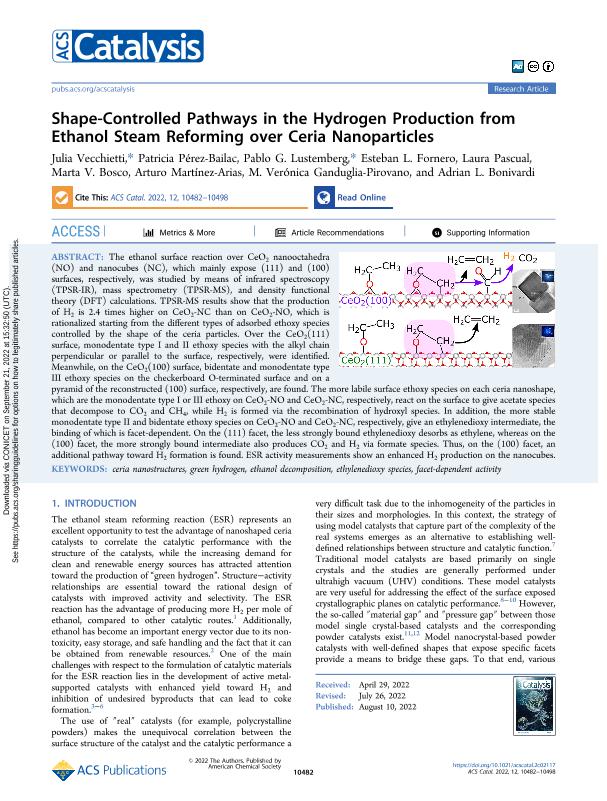Mostrar el registro sencillo del ítem
dc.contributor.author
Vecchietti, María Julia

dc.contributor.author
Pérez Bailac, Patricia
dc.contributor.author
Lustemberg, Pablo German

dc.contributor.author
Fornero, Esteban Luis

dc.contributor.author
Pascual, Laura
dc.contributor.author
Bosco, Marta Verónica

dc.contributor.author
Martínez Arias, Arturo
dc.contributor.author
Ganduglia Pirovano, M. Verónica
dc.contributor.author
Bonivardi, Adrian Lionel

dc.date.available
2023-08-24T14:26:27Z
dc.date.issued
2022-08
dc.identifier.citation
Vecchietti, María Julia; Pérez Bailac, Patricia; Lustemberg, Pablo German; Fornero, Esteban Luis; Pascual, Laura; et al.; Shape-Controlled Pathways in the Hydrogen Production from Ethanol Steam Reforming over Ceria Nanoparticles; American Chemical Society; ACS Catalysis; 12; 16; 8-2022; 10482-10498
dc.identifier.issn
2155-5435
dc.identifier.uri
http://hdl.handle.net/11336/209251
dc.description.abstract
The ethanol surface reaction over CeO2nanooctahedra (NO) and nanocubes (NC), which mainly expose (111) and (100) surfaces, respectively, was studied by means of infrared spectroscopy (TPSR-IR), mass spectrometry (TPSR-MS), and density functional theory (DFT) calculations. TPSR-MS results show that the production of H2is 2.4 times higher on CeO2-NC than on CeO2-NO, which is rationalized starting from the different types of adsorbed ethoxy species controlled by the shape of the ceria particles. Over the CeO2(111) surface, monodentate type I and II ethoxy species with the alkyl chain perpendicular or parallel to the surface, respectively, were identified. Meanwhile, on the CeO2(100) surface, bidentate and monodentate type III ethoxy species on the checkerboard O-terminated surface and on a pyramid of the reconstructed (100) surface, respectively, are found. The more labile surface ethoxy species on each ceria nanoshape, which are the monodentate type I or III ethoxy on CeO2-NO and CeO2-NC, respectively, react on the surface to give acetate species that decompose to CO2and CH4, while H2is formed via the recombination of hydroxyl species. In addition, the more stable monodentate type II and bidentate ethoxy species on CeO2-NO and CeO2-NC, respectively, give an ethylenedioxy intermediate, the binding of which is facet-dependent. On the (111) facet, the less strongly bound ethylenedioxy desorbs as ethylene, whereas on the (100) facet, the more strongly bound intermediate also produces CO2and H2via formate species. Thus, on the (100) facet, an additional pathway toward H2formation is found. ESR activity measurements show an enhanced H2production on the nanocubes.
dc.format
application/pdf
dc.language.iso
eng
dc.publisher
American Chemical Society

dc.rights
info:eu-repo/semantics/openAccess
dc.rights.uri
https://creativecommons.org/licenses/by/2.5/ar/
dc.subject
CERIA NANOSTRUCTURES
dc.subject
ETHANOL DECOMPOSITION
dc.subject
ETHYLENEDIOXY SPECIES
dc.subject
FACET-DEPENDENT ACTIVITY
dc.subject
GREEN HYDROGEN
dc.subject.classification
Ingeniería de Procesos Químicos

dc.subject.classification
Ingeniería Química

dc.subject.classification
INGENIERÍAS Y TECNOLOGÍAS

dc.subject.classification
Otras Ingeniería de los Materiales

dc.subject.classification
Ingeniería de los Materiales

dc.subject.classification
INGENIERÍAS Y TECNOLOGÍAS

dc.title
Shape-Controlled Pathways in the Hydrogen Production from Ethanol Steam Reforming over Ceria Nanoparticles
dc.type
info:eu-repo/semantics/article
dc.type
info:ar-repo/semantics/artículo
dc.type
info:eu-repo/semantics/publishedVersion
dc.date.updated
2023-07-17T17:26:40Z
dc.identifier.eissn
2155-5435
dc.journal.volume
12
dc.journal.number
16
dc.journal.pagination
10482-10498
dc.journal.pais
Estados Unidos

dc.description.fil
Fil: Vecchietti, María Julia. Consejo Nacional de Investigaciones Científicas y Técnicas. Centro Científico Tecnológico Conicet - Santa Fe. Instituto de Desarrollo Tecnológico para la Industria Química. Universidad Nacional del Litoral. Instituto de Desarrollo Tecnológico para la Industria Química; Argentina
dc.description.fil
Fil: Pérez Bailac, Patricia. Universidad Autónoma de Madrid; España
dc.description.fil
Fil: Lustemberg, Pablo German. Consejo Nacional de Investigaciones Científicas y Técnicas. Centro Científico Tecnológico Conicet - Rosario. Instituto de Física de Rosario. Universidad Nacional de Rosario. Instituto de Física de Rosario; Argentina
dc.description.fil
Fil: Fornero, Esteban Luis. Consejo Nacional de Investigaciones Científicas y Técnicas. Centro Científico Tecnológico Conicet - Santa Fe. Instituto de Desarrollo Tecnológico para la Industria Química. Universidad Nacional del Litoral. Instituto de Desarrollo Tecnológico para la Industria Química; Argentina
dc.description.fil
Fil: Pascual, Laura. Consejo Superior de Investigaciones Científicas; España
dc.description.fil
Fil: Bosco, Marta Verónica. Consejo Nacional de Investigaciones Científicas y Técnicas. Centro Científico Tecnológico Conicet - Santa Fe. Instituto de Desarrollo Tecnológico para la Industria Química. Universidad Nacional del Litoral. Instituto de Desarrollo Tecnológico para la Industria Química; Argentina
dc.description.fil
Fil: Martínez Arias, Arturo. Consejo Superior de Investigaciones Científicas; España
dc.description.fil
Fil: Ganduglia Pirovano, M. Verónica. Consejo Superior de Investigaciones Científicas; España
dc.description.fil
Fil: Bonivardi, Adrian Lionel. Consejo Nacional de Investigaciones Científicas y Técnicas. Centro Científico Tecnológico Conicet - Santa Fe. Instituto de Desarrollo Tecnológico para la Industria Química. Universidad Nacional del Litoral. Instituto de Desarrollo Tecnológico para la Industria Química; Argentina
dc.journal.title
ACS Catalysis
dc.relation.alternativeid
info:eu-repo/semantics/altIdentifier/url/https://pubs.acs.org/doi/10.1021/acscatal.2c02117
dc.relation.alternativeid
info:eu-repo/semantics/altIdentifier/doi/http://dx.doi.org/10.1021/acscatal.2c02117
Archivos asociados
